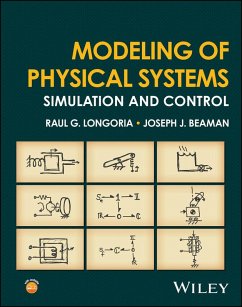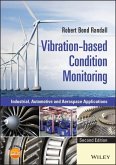Raul G. Longoria (University of Texas, Austin, TX), Joseph J. Beaman (University of Texas, Austin, TX)
Modeling of Physical Systems
Simulation and Control
Raul G. Longoria (University of Texas, Austin, TX), Joseph J. Beaman (University of Texas, Austin, TX)
Modeling of Physical Systems
Simulation and Control
- Gebundenes Buch
- Merkliste
- Auf die Merkliste
- Bewerten Bewerten
- Teilen
- Produkt teilen
- Produkterinnerung
- Produkterinnerung
With an introduction to nonlinear and continuous systems using bond graph methodology, this book gives readers the foundations they need to apply physical system models in practice. It uses non linear modeling approaches.
Andere Kunden interessierten sich auch für
![Theory of Ground Vehicles Theory of Ground Vehicles]() J. Y. Wong (Ontario Carleton University)Theory of Ground Vehicles104,99 €
J. Y. Wong (Ontario Carleton University)Theory of Ground Vehicles104,99 €![Multiscale Modelling and Optimisation of Materials and Structures Multiscale Modelling and Optimisation of Materials and Structures]() Tadeusz Burczynski (Silesian University of Technology)Multiscale Modelling and Optimisation of Materials and Structures156,99 €
Tadeusz Burczynski (Silesian University of Technology)Multiscale Modelling and Optimisation of Materials and Structures156,99 €![Autonomous Road Vehicle Path Planning and Tracking Control Autonomous Road Vehicle Path Planning and Tracking Control]() Levent GuvencAutonomous Road Vehicle Path Planning and Tracking Control124,99 €
Levent GuvencAutonomous Road Vehicle Path Planning and Tracking Control124,99 €![Noise and Vibration Analysis Noise and Vibration Analysis]() Anders Brandt (University of Southern Denmark)Noise and Vibration Analysis116,99 €
Anders Brandt (University of Southern Denmark)Noise and Vibration Analysis116,99 €![Vibration-based Condition Moni Vibration-based Condition Moni]() Robert Bond Randall (Australia University of New South Wales)Vibration-based Condition Moni142,99 €
Robert Bond Randall (Australia University of New South Wales)Vibration-based Condition Moni142,99 €![Engineering for Sustainable Development Engineering for Sustainable Development]() Wahidul K. Biswas (Curtin University, Perth, Australia)Engineering for Sustainable Development108,99 €
Wahidul K. Biswas (Curtin University, Perth, Australia)Engineering for Sustainable Development108,99 €![Metal Additive Manufacturing Metal Additive Manufacturing]() Ehsan Toyserkani (University of Waterloo, ON, Canada)Metal Additive Manufacturing142,99 €
Ehsan Toyserkani (University of Waterloo, ON, Canada)Metal Additive Manufacturing142,99 €-
-
-
With an introduction to nonlinear and continuous systems using bond graph methodology, this book gives readers the foundations they need to apply physical system models in practice. It uses non linear modeling approaches.
Hinweis: Dieser Artikel kann nur an eine deutsche Lieferadresse ausgeliefert werden.
Hinweis: Dieser Artikel kann nur an eine deutsche Lieferadresse ausgeliefert werden.
Produktdetails
- Produktdetails
- Verlag: Wiley / Wiley & Sons
- Artikelnr. des Verlages: 1W119945040
- 1. Auflage
- Seitenzahl: 656
- Erscheinungstermin: 22. Mai 2025
- Englisch
- Abmessung: 280mm x 223mm x 41mm
- Gewicht: 1842g
- ISBN-13: 9781119945048
- ISBN-10: 1119945046
- Artikelnr.: 41748743
- Herstellerkennzeichnung
- Libri GmbH
- Europaallee 1
- 36244 Bad Hersfeld
- gpsr@libri.de
- Verlag: Wiley / Wiley & Sons
- Artikelnr. des Verlages: 1W119945040
- 1. Auflage
- Seitenzahl: 656
- Erscheinungstermin: 22. Mai 2025
- Englisch
- Abmessung: 280mm x 223mm x 41mm
- Gewicht: 1842g
- ISBN-13: 9781119945048
- ISBN-10: 1119945046
- Artikelnr.: 41748743
- Herstellerkennzeichnung
- Libri GmbH
- Europaallee 1
- 36244 Bad Hersfeld
- gpsr@libri.de
Raul G. Longoria, Professor, Walker Department of Mechanical Engineering, University of Texas at Austin. Professor Longoria has over 30 years of experience in the field and has taught the methods described in this book in undergraduate and graduate level courses. He has applied these multidisciplinary modeling and simulation methods in a wide-range of industry and government projects throughout his academic research and consulting career. Joseph J. Beaman, Professor and former Department Chair (2001 to 2012) of Walker Department of Mechanical Engineering, University of Texas at Austin, has more than 40 years of experience in the field. He was one of the founders of DTM Corporation (now merged with 3D systems). Professor Beaman was elected to the National Academy of Engineers and the National Academy of Inventors, given the CIRP Nicolau award, and elected Honorary Member of ASME.
Preface xv
About the Companion Website xvii
1 Introduction 1
1.1 System Modeling Concepts 1
1.2 General Steps in Modeling 2
1.3 Definitions of System Modeling Concepts 3
1.4 Energy Basis for Physical System Modeling 5
1.5 Relation to Classical Dynamics 10
1.6 Power Flow in Physical System Modeling 12
1.7 Outline of the Text 15
1.8 Problems 16
2 Kirchhoff Systems 23
2.1 Mechanical Translation 23
2.2 Mechanical Rotation 32
2.3 Electric Systems 40
2.4 Hydraulic Systems 50
2.5 Ideal Couplers 57
2.6 Thermal System Elements and Effects 60
2.7 State-Space and Numerical Response Analysis 69
2.8 Summary 78
2.9 Problems 78
3 Physical Modeling with Bond Graphs 91
3.1 Bond Graph Variables 93
3.2 Bond Graph Elements 94
3.3 Modeling Examples 102
3.4 Algorithmic Conversion of Schematics to Bond Graphs 106
3.5 Causality 109
3.6 State Variables and State Equation Derivation 113
3.7 Thermal Effects in Bond Graph Models 124
3.8 Summary 134
3.9 Problems 138
4 System Model Formulation and Evaluation 155
4.1 Equilibrium Analysis 156
4.2 Linearization Techniques 165
4.3 Signals and Block Diagrams with Causal Bond Graphs 170
4.4 Transfer Functions 175
4.5 Stability of Physical Systems 181
4.6 Constitutive Structure 188
4.7 Modulation Structure 195
4.8 Summary 215
4.9 Problems 216
5 Linear System Modeling and Analysis 239
5.1 Analysis of First-Order System Models 239
5.2 Analysis of Second-Order System Models 246
5.3 Application of Model Response 256
5.4 Analysis Using System Model Transfer Functions 263
5.5 Poles and Zeros from Transfer Function Models 268
5.6 Response of nth-Order Linear Systems 272
5.7 Forced Response of nth-Order Systems 278
5.8 Forced Response from Transfer Functions 281
5.9 Chapter Summary 283
5.10 Problems 283
6 Frequency Response and Impedance-Based Modeling 299
6.1 Frequency Response 299
6.2 Basic Factors of Frequency Response Functions 305
6.3 Impedance Methods Using Bond Graphs 310
6.4 Applications of Frequency Response 317
6.5 Two-Port Models and Transmission Matrices 330
6.6 Additional Application of Impedance Formulations 344
6.7 Summary 360
6.8 Problems 360
7 Modeling Feedback Control Systems 375
7.1 Feedback Control Representations 375
7.2 Modeling Control System Elements 379
7.3 Closed-Loop Feedback Control 388
7.4 Linear Feedback Controllers and Compensators 396
7.5 State Variable Control Methods 424
7.6 Simulation of Controlled Systems 453
7.7 Summary 460
7.8 Problems 461
8 Multiport Modeling and Energy Methods 475
8.1 Multiport Concept and Usage 475
8.2 Causality and Constitutive Relations for Multiports 480
8.3 Electromechanical Systems Modeling 488
8.4 Lagrange's Equations in System Modeling 508
8.5 Variational and Minimum Principles 533
8.6 Chapter Summary 537
8.7 Problems 537
9 Thermodynamic Systems 557
9.1 Thermodynamic Systems and Relations 557
9.2 Equations of State for Ideal Gases 565
9.3 Applications in Thermomechanical Systems 572
9.4 Modeling Open Thermo-Fluid Systems 576
9.5 Multicomponent Systems 592
9.6 Open System Effects and Diffusion 597
9.7 Systems with Chemical Reactions 609
9.8 Chapter Summary 617
9.9 Problems 617
References 625
Index 633
About the Companion Website xvii
1 Introduction 1
1.1 System Modeling Concepts 1
1.2 General Steps in Modeling 2
1.3 Definitions of System Modeling Concepts 3
1.4 Energy Basis for Physical System Modeling 5
1.5 Relation to Classical Dynamics 10
1.6 Power Flow in Physical System Modeling 12
1.7 Outline of the Text 15
1.8 Problems 16
2 Kirchhoff Systems 23
2.1 Mechanical Translation 23
2.2 Mechanical Rotation 32
2.3 Electric Systems 40
2.4 Hydraulic Systems 50
2.5 Ideal Couplers 57
2.6 Thermal System Elements and Effects 60
2.7 State-Space and Numerical Response Analysis 69
2.8 Summary 78
2.9 Problems 78
3 Physical Modeling with Bond Graphs 91
3.1 Bond Graph Variables 93
3.2 Bond Graph Elements 94
3.3 Modeling Examples 102
3.4 Algorithmic Conversion of Schematics to Bond Graphs 106
3.5 Causality 109
3.6 State Variables and State Equation Derivation 113
3.7 Thermal Effects in Bond Graph Models 124
3.8 Summary 134
3.9 Problems 138
4 System Model Formulation and Evaluation 155
4.1 Equilibrium Analysis 156
4.2 Linearization Techniques 165
4.3 Signals and Block Diagrams with Causal Bond Graphs 170
4.4 Transfer Functions 175
4.5 Stability of Physical Systems 181
4.6 Constitutive Structure 188
4.7 Modulation Structure 195
4.8 Summary 215
4.9 Problems 216
5 Linear System Modeling and Analysis 239
5.1 Analysis of First-Order System Models 239
5.2 Analysis of Second-Order System Models 246
5.3 Application of Model Response 256
5.4 Analysis Using System Model Transfer Functions 263
5.5 Poles and Zeros from Transfer Function Models 268
5.6 Response of nth-Order Linear Systems 272
5.7 Forced Response of nth-Order Systems 278
5.8 Forced Response from Transfer Functions 281
5.9 Chapter Summary 283
5.10 Problems 283
6 Frequency Response and Impedance-Based Modeling 299
6.1 Frequency Response 299
6.2 Basic Factors of Frequency Response Functions 305
6.3 Impedance Methods Using Bond Graphs 310
6.4 Applications of Frequency Response 317
6.5 Two-Port Models and Transmission Matrices 330
6.6 Additional Application of Impedance Formulations 344
6.7 Summary 360
6.8 Problems 360
7 Modeling Feedback Control Systems 375
7.1 Feedback Control Representations 375
7.2 Modeling Control System Elements 379
7.3 Closed-Loop Feedback Control 388
7.4 Linear Feedback Controllers and Compensators 396
7.5 State Variable Control Methods 424
7.6 Simulation of Controlled Systems 453
7.7 Summary 460
7.8 Problems 461
8 Multiport Modeling and Energy Methods 475
8.1 Multiport Concept and Usage 475
8.2 Causality and Constitutive Relations for Multiports 480
8.3 Electromechanical Systems Modeling 488
8.4 Lagrange's Equations in System Modeling 508
8.5 Variational and Minimum Principles 533
8.6 Chapter Summary 537
8.7 Problems 537
9 Thermodynamic Systems 557
9.1 Thermodynamic Systems and Relations 557
9.2 Equations of State for Ideal Gases 565
9.3 Applications in Thermomechanical Systems 572
9.4 Modeling Open Thermo-Fluid Systems 576
9.5 Multicomponent Systems 592
9.6 Open System Effects and Diffusion 597
9.7 Systems with Chemical Reactions 609
9.8 Chapter Summary 617
9.9 Problems 617
References 625
Index 633
Preface xv
About the Companion Website xvii
1 Introduction 1
1.1 System Modeling Concepts 1
1.2 General Steps in Modeling 2
1.3 Definitions of System Modeling Concepts 3
1.4 Energy Basis for Physical System Modeling 5
1.5 Relation to Classical Dynamics 10
1.6 Power Flow in Physical System Modeling 12
1.7 Outline of the Text 15
1.8 Problems 16
2 Kirchhoff Systems 23
2.1 Mechanical Translation 23
2.2 Mechanical Rotation 32
2.3 Electric Systems 40
2.4 Hydraulic Systems 50
2.5 Ideal Couplers 57
2.6 Thermal System Elements and Effects 60
2.7 State-Space and Numerical Response Analysis 69
2.8 Summary 78
2.9 Problems 78
3 Physical Modeling with Bond Graphs 91
3.1 Bond Graph Variables 93
3.2 Bond Graph Elements 94
3.3 Modeling Examples 102
3.4 Algorithmic Conversion of Schematics to Bond Graphs 106
3.5 Causality 109
3.6 State Variables and State Equation Derivation 113
3.7 Thermal Effects in Bond Graph Models 124
3.8 Summary 134
3.9 Problems 138
4 System Model Formulation and Evaluation 155
4.1 Equilibrium Analysis 156
4.2 Linearization Techniques 165
4.3 Signals and Block Diagrams with Causal Bond Graphs 170
4.4 Transfer Functions 175
4.5 Stability of Physical Systems 181
4.6 Constitutive Structure 188
4.7 Modulation Structure 195
4.8 Summary 215
4.9 Problems 216
5 Linear System Modeling and Analysis 239
5.1 Analysis of First-Order System Models 239
5.2 Analysis of Second-Order System Models 246
5.3 Application of Model Response 256
5.4 Analysis Using System Model Transfer Functions 263
5.5 Poles and Zeros from Transfer Function Models 268
5.6 Response of nth-Order Linear Systems 272
5.7 Forced Response of nth-Order Systems 278
5.8 Forced Response from Transfer Functions 281
5.9 Chapter Summary 283
5.10 Problems 283
6 Frequency Response and Impedance-Based Modeling 299
6.1 Frequency Response 299
6.2 Basic Factors of Frequency Response Functions 305
6.3 Impedance Methods Using Bond Graphs 310
6.4 Applications of Frequency Response 317
6.5 Two-Port Models and Transmission Matrices 330
6.6 Additional Application of Impedance Formulations 344
6.7 Summary 360
6.8 Problems 360
7 Modeling Feedback Control Systems 375
7.1 Feedback Control Representations 375
7.2 Modeling Control System Elements 379
7.3 Closed-Loop Feedback Control 388
7.4 Linear Feedback Controllers and Compensators 396
7.5 State Variable Control Methods 424
7.6 Simulation of Controlled Systems 453
7.7 Summary 460
7.8 Problems 461
8 Multiport Modeling and Energy Methods 475
8.1 Multiport Concept and Usage 475
8.2 Causality and Constitutive Relations for Multiports 480
8.3 Electromechanical Systems Modeling 488
8.4 Lagrange's Equations in System Modeling 508
8.5 Variational and Minimum Principles 533
8.6 Chapter Summary 537
8.7 Problems 537
9 Thermodynamic Systems 557
9.1 Thermodynamic Systems and Relations 557
9.2 Equations of State for Ideal Gases 565
9.3 Applications in Thermomechanical Systems 572
9.4 Modeling Open Thermo-Fluid Systems 576
9.5 Multicomponent Systems 592
9.6 Open System Effects and Diffusion 597
9.7 Systems with Chemical Reactions 609
9.8 Chapter Summary 617
9.9 Problems 617
References 625
Index 633
About the Companion Website xvii
1 Introduction 1
1.1 System Modeling Concepts 1
1.2 General Steps in Modeling 2
1.3 Definitions of System Modeling Concepts 3
1.4 Energy Basis for Physical System Modeling 5
1.5 Relation to Classical Dynamics 10
1.6 Power Flow in Physical System Modeling 12
1.7 Outline of the Text 15
1.8 Problems 16
2 Kirchhoff Systems 23
2.1 Mechanical Translation 23
2.2 Mechanical Rotation 32
2.3 Electric Systems 40
2.4 Hydraulic Systems 50
2.5 Ideal Couplers 57
2.6 Thermal System Elements and Effects 60
2.7 State-Space and Numerical Response Analysis 69
2.8 Summary 78
2.9 Problems 78
3 Physical Modeling with Bond Graphs 91
3.1 Bond Graph Variables 93
3.2 Bond Graph Elements 94
3.3 Modeling Examples 102
3.4 Algorithmic Conversion of Schematics to Bond Graphs 106
3.5 Causality 109
3.6 State Variables and State Equation Derivation 113
3.7 Thermal Effects in Bond Graph Models 124
3.8 Summary 134
3.9 Problems 138
4 System Model Formulation and Evaluation 155
4.1 Equilibrium Analysis 156
4.2 Linearization Techniques 165
4.3 Signals and Block Diagrams with Causal Bond Graphs 170
4.4 Transfer Functions 175
4.5 Stability of Physical Systems 181
4.6 Constitutive Structure 188
4.7 Modulation Structure 195
4.8 Summary 215
4.9 Problems 216
5 Linear System Modeling and Analysis 239
5.1 Analysis of First-Order System Models 239
5.2 Analysis of Second-Order System Models 246
5.3 Application of Model Response 256
5.4 Analysis Using System Model Transfer Functions 263
5.5 Poles and Zeros from Transfer Function Models 268
5.6 Response of nth-Order Linear Systems 272
5.7 Forced Response of nth-Order Systems 278
5.8 Forced Response from Transfer Functions 281
5.9 Chapter Summary 283
5.10 Problems 283
6 Frequency Response and Impedance-Based Modeling 299
6.1 Frequency Response 299
6.2 Basic Factors of Frequency Response Functions 305
6.3 Impedance Methods Using Bond Graphs 310
6.4 Applications of Frequency Response 317
6.5 Two-Port Models and Transmission Matrices 330
6.6 Additional Application of Impedance Formulations 344
6.7 Summary 360
6.8 Problems 360
7 Modeling Feedback Control Systems 375
7.1 Feedback Control Representations 375
7.2 Modeling Control System Elements 379
7.3 Closed-Loop Feedback Control 388
7.4 Linear Feedback Controllers and Compensators 396
7.5 State Variable Control Methods 424
7.6 Simulation of Controlled Systems 453
7.7 Summary 460
7.8 Problems 461
8 Multiport Modeling and Energy Methods 475
8.1 Multiport Concept and Usage 475
8.2 Causality and Constitutive Relations for Multiports 480
8.3 Electromechanical Systems Modeling 488
8.4 Lagrange's Equations in System Modeling 508
8.5 Variational and Minimum Principles 533
8.6 Chapter Summary 537
8.7 Problems 537
9 Thermodynamic Systems 557
9.1 Thermodynamic Systems and Relations 557
9.2 Equations of State for Ideal Gases 565
9.3 Applications in Thermomechanical Systems 572
9.4 Modeling Open Thermo-Fluid Systems 576
9.5 Multicomponent Systems 592
9.6 Open System Effects and Diffusion 597
9.7 Systems with Chemical Reactions 609
9.8 Chapter Summary 617
9.9 Problems 617
References 625
Index 633








